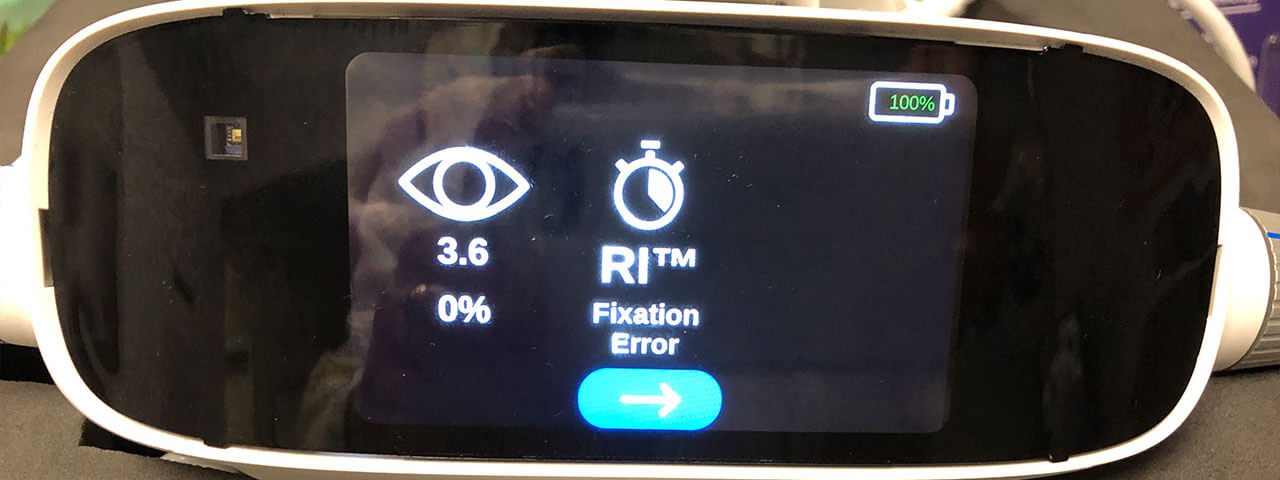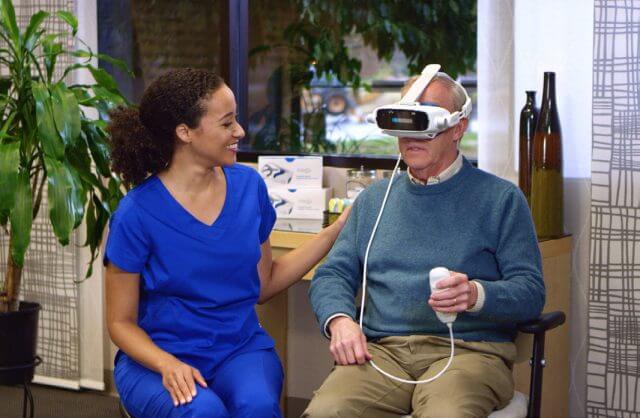
About Dark Adaptation
People with age-related macular degeneration (AMD) often do not know they have the disease during its early stages. They may dismiss early warning signs, like trouble seeing at night, as part of the normal aging process. Ignoring these symptoms only delays diagnosis, which can lead to more vision loss.
We are offering a new test that helps us diagnose AMD at a very early stage and monitor disease progression. If you are experiencing problems seeing at night, or it is becoming increasing difficult to read in dim light, talk to us about scheduling an AdaptDx [adapt-dee-ex] Pro test.
AdaptDx Pro Dark Adaptometer

The AdaptDx Pro aids in the detection and management of AMD. It measures the time it takes for your vision to adjust to the dark. This is called dark adaptation. The simple test takes less than 10 minutes. You’ll wear a comfortable headset and follow the instructions from an artificial intelligence-driven technician named Theia, who will guide you through the test. Nothing will touch your eye. If the AdaptDx Pro test indicates signs of early AMD, you and your doctor have valuable time to develop a plan to delay disease progression.
What is RI?
“RI” stands for Rod Intercept,™ the time it takes for the eye to adjust from bright light to darkness When you take the AdaptDxPro test, the device calculates your RI number and provides your doctor with critical information to help determine whether or not you have AMD.
Is the AdaptDx Pro test covered by insurance?
We may be able to bill the test to your insurance provider if there is a medical diagnosis related to AMD or you are experiencing trouble seeing in dim or dark environments. If not, the AdaptDx Pro test may require a modest out-of-pocket charge.
What should I expect during the test?
Watch this video that shows you exactly what to expect during the test:
Age-Related Macular Degeneration
Age-related macular degeneration or AMD is the leading cause of adult blindness in developed countries and affects nearly 1in 8 adults over the age of 60. AMD is a chronic, progressive disease that attacks the macula, a part of the retina that allows us to see objects located straight ahead of us. The macula is responsible for your central vision, which allows you to do things like recognize faces, read, and watch TV.
Stages of Age-Related Macular Degeneration
As a progressive disease, AMD reveals itself in stages.
- Subclinical AMD
This the earliest detectable stage of age-related macular degeneration. The first warning sign is trouble seeing at night. Many people blame poor night vision on the normal aging process and don’t report the symptom to their doctor. Don’t make that mistake. If you begin having difficulty reading in dim light or adjusting to seeing in the dark, let us know. Identifying AMD at this point is critical to proactively manage the disease. - Early to Intermediate AMD
Before we learned that dark adaptation is the first symptom of AMD, eye care professionals relied on identifying the disease during the early or intermediate stages by identifying drusen – yellow fatty deposits under your retina – which is a physical indicator of AMD. - Advanced AMD
Patients notice central vision blurriness as the disease advances. The transition from early-stage to late-stage AMD happens rapidly. If left untreated, it can lead to legal blindness in as little as six months. While treatment options can slow the progression of late AMD, nothing can reverse the damage already done.
AMD Symptoms and Risk Factors
The earliest symptom of AMD is impaired dark adaptation, which may cause difficulty seeing at night. As the disease progresses, symptoms may include distortion of straight lines or dark and blurry central vision.
There are several factors that may increase your risk, including:
Age 50 or older
- Family history of AMD
- Caucasian (white)
- Smoker or past smoker
- Overweight
- Heart disease, high blood pressure, or high cholesterol
Age is the biggest risk factor. In fact, 1 in 8 adults over the age of 60 has age-related macular degeneration (AMD). If you are experiencing a symptom of AMD or have multiple risk factors, let us know and we may test your eyes with the AdaptDx Pro.
What happens if AMD is detected?
If you are diagnosed with AMD, we have valuable time to develop a plan to delay further symptoms.
Proactive steps to delay or prevent vision loss include:
- Lifestyle changes, such as improved diet and exercise
- Smoking cessation.
- Eye health supplements
- Blue light protection
- UVA and UVB protection
We will also want to monitor your vision regularly. It is very important to follow up with testing as indicated, so we may promptly intervene should complications occur. If needed, you’ll be able to begin additional treatment as soon as late-stage AMD is detected.
For more information, please click here.
